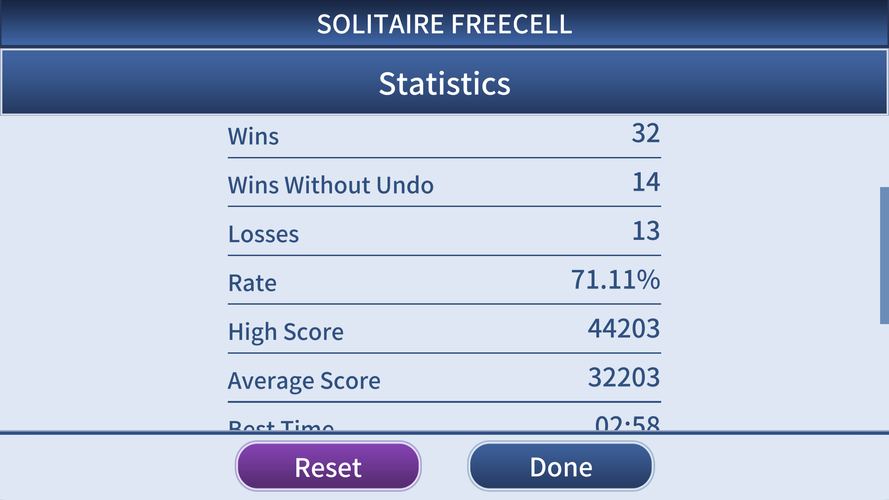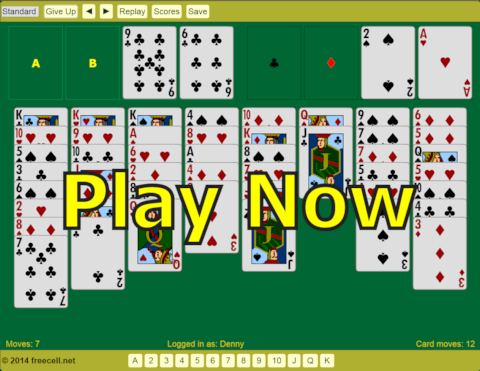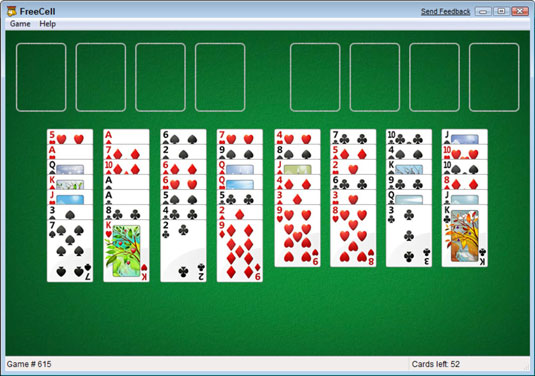Cell Card Game
FreeCell Solitaire adds a new element of strategy to the classic solitaire games Klondike. After dealing from a standard deck of 52 cards, use the four free cell spots as placeholders as you try to move all of the cards from the Foundation stacks for a win.
FreeCell Rules
The different piles
There are three different types of piles in FreeCell Solitaire. They are:
- The Free Cells: The four piles in the upper left corner.
- The Foundations: The four piles in the upper right corner.
- The Tableau: The eight piles that make up the main table.

FreeCell Solitaire is one of the most popular Solitaire card games. Solitaire games require skill, strategy and patience to win. After dealing from a standard deck of 52 cards, use the four free cell spots as placeholders as you try to move all of the cards from the Tableau for a win. Want More Solitaire Games? Try SolSuite Solitaire, the World's Most Complete Solitaire Collection with more than 700 solitaire games, 60 card sets, 300 card backs and 100 backgrounds! Try it now at www.solsuite.com. More Free Games. Spider Solitaire Play in your browser a beautiful and free Spider solitaire games collection. Free Cell is based on solitaire and played with one full deck of cards. This is a skill game, as it possible to win almost every Free Cell game. Play in Free Cell begins with eight tableaux which include all playable cards, four foundational spots, and four open cells. Cards may be moved in and out of the free cells.

The setup
The Tableau piles are numbered from 1 to 8, piles 1-4 start with 7 cards each, piles 5-8 with 6 cards each. The Foundations and Free Cells are empty.
The objective
Free Cell Card Game Rules
To win FreeCell, you must get all the cards onto the Foundations. The Foundations are ordered by suit and rank, each Foundation has one suit and you must put the cards onto them in the order Ace 2 3 4 5 6 7 8 9 10 Jack Queen King. To do that you can use the moves described below:
Allowed moves
- Move one or more cards from one Tableau pile to another. You can move the top card of a pile on the Tableau onto another Tableau pile, if that pile's top card is one higher than the moved card and in a different color. For example, you could move a red 6 onto a black 7. If the top cards on a Tableau pile are ordered, e.g. you have red 6, black 5, red 4 as the top cards, then you can click the red 6 and move all of them together onto another Tableau pile that has a black 7 as its top card. HOWEVER, there is a limitation to how many ordered cards you can move together. The number of cards you can move together is basically the number of empty free cells and empty tableaus + 1. So, if you have 2 free cells empty you can move 3 cards together. If you have all 4 free cells empty you can move 5 cards. If you have 3 free cells and 4 empty tableaus you can move 8 cards together. Moving many cards together is basically just a convenience the game provides. In the strictest sense you should always move one at a time, but if you have 4 ordered cards and 3 free cells then you could trivially move the top 3 ordered cards to the free cells, then move the fourth card and then move the 3 cards from the free cells back onto the fourth card. So, for convenience the game allows you to move n+1 cards together, where n is the number of free cells.
If you have an empty Tableau pile then you can move any card there. - Move a single card onto a Free Cell. You can always move the top card of any Tableau Pile, Free Cell or Foundation onto a Free Cell if it's empty. Free Cell's can only hold a single card at a time.
- Move a card from a Free Cell. You can move a card from a Free Cell onto a Foundation if it's in the same suit and one higher than the Foundation's top card. Or you can move a card from a Free Cell onto a Tableau pile if the card is one lower and in a different color than the Tableau pile's top card. E.g. you could move a red 5 from a Free Cell onto a Tableau pile where the current top card was a black 6.
- You can move a Tableau card onto the Foundations. You can either drag the cards onto the Foundation, or just double click it and then it will go there by itself. When the Free Cells are empty and all cards on the Tableau are arranged in 4 piles and each of the piles has been ordered in descending order with alternating red/black cards then the Tableau will clear itself, since at that point you are guaranteed to win the game.
- You can Undo as many times as you like. The game offers unlimited undos. Each Undo counts as a new move though, so if you're trying to win the game in as few moves as possible you should be careful about how many undos you use.
Time and Moves
The game counts the moves you make, and measures the time it takes to finish the game, so you can compete against your previous best games if you want. Currently this data is not stored anywhere, in the future I might add some kind of high scores.
About FreeCell
Hi. My name is Einar Egilsson and I made this online verson of FreeCell. FreeCell is the second solitaire game I create, before that I created Klondike (or 'classic' solitaire) and I've also made a few card games like Hearts, Spades and Whist.
If you have any questions, comments or requests for other solitaire games you can send them to admin@cardgames.io or tweet at me @cardgames_io. If you have any errors or problems when playing the game please include which browser you're using when you email me, it makes figuring out the problem a lot easier :)
Many thanks go to Nicu Buculei, who created the excellent playing card images that I use for the game.
If you like this game check out my various other games, and please share them on Facebook/Twitter/Google+
This is version 2797 of FreeCell.
This website uses cookies to store your preferences, and for advertising purposes. Read more in our Privacy Policy or manage your privacy settings.
Finish a Phase in the newest rummy inspired game from the creators of the UNO! It is the competition which has brought friends and families together for over 30 years. Now, it can take you around the world!
Race to complete each “Phase” and stay ahead. Every Phase has its own sets of cards to collect. When you have your sets, throw them down for everyone to see. The Phase is finished!
How To Play
The object of the game is to be the first person to complete all ten phases. In the case of two players completing the last phase in the same hand, the player who completed the last phase with the lowest overall score is the winner. If those scores also happen to be tied, a tiebreaker round is played where the tying players attempt to complete phase ten (or in variants, the last phase each player had tried to complete in the previous round).
For each hand, each player’s object is to complete and lay down the current phase, and then rid their hand of remaining cards by discarding them on laid-down Phases, called “hitting”. The player who does this first wins the hand and scores no penalty; all other players earn penalty points according to the value of cards remaining in their hand.
There are one hundred and eight cards in a deck:
Cell Phone Card Game
- ninety-six numbered cards: two of each value from one through twelve, in each of four colors. Therefore, there are 24 cards of each color and eight of each value.
- eight Wild cards;
- four Skip cards;

With two regular decks of cards, the suits can represent the four different colors, kings can represent the wild cards, and jokers can represent the skip cards.

Credits
Phase 10 is a card game created in 1982 by Kenneth Johnson.
More Games
Hearts - In Hearts, the goal is to get as few points as possible. Game ends when someone reaches 100 points. The player with the lowest score wins.
Freecell Card Games
Deep Sea Tri Peaks - Explore the mysteries of the Deep Sea with Solitaire TriPeaks, the classic solitaire card game which allows you to train your brain with different solitaire puzzles.
